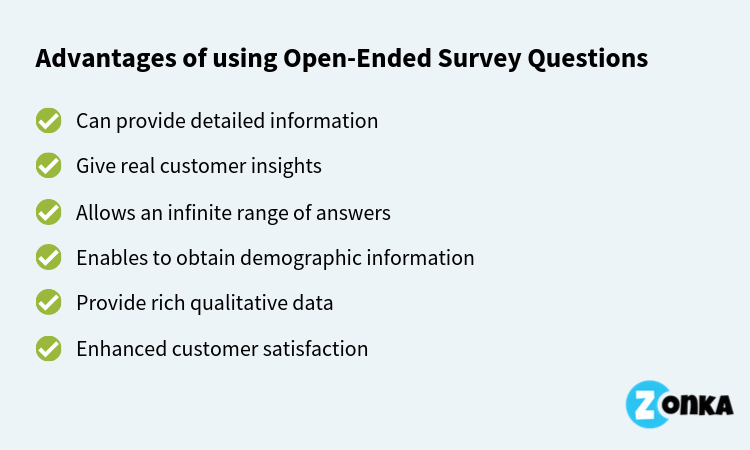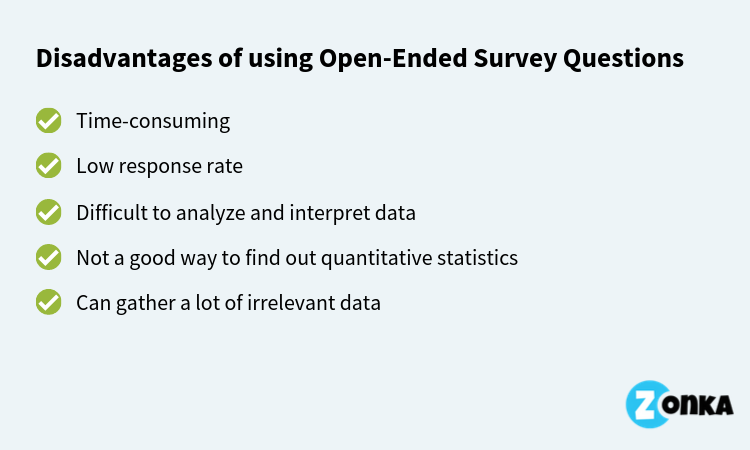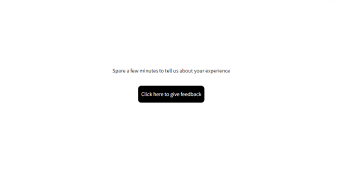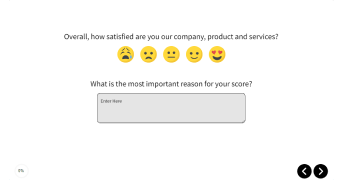Open-Ended Questions
An open-ended question refers to a question in which options are not provided to your customers to choose their answers. Rather, it is informative in nature and enables your customers to express their viewpoints through freestyle answers which may be in the form of sentences, records, and stories. As the name suggests, customers while filling the open-ended survey questions are open to give any feedback in their own words.
You can choose different types of survey questions while designing your feedback form. You can choose open-ended as well as closed-ended questions considering the advantages and disadvantages of both. Let us review here about open-ended questions.
Open Ended Survey Templates
Advantages of Open-Ended Questions
There are some useful advantages of open-ended questions especially when you need to collect rich and high-quality data. Let’s review them here.

1. Can provide detailed information
Open-ended questions help a lot in providing a piece of more detailed information. Whenever you want to gather details of any aspect, for instance, the experience of any particular service provided by the company; open-ended questions are the best ones to have in your feedback form.
2. Give real customer insights
Open-ended questions enable you to get real customer insights regarding your products/services and their experience in their own words. You get to know their perceptions, opinions, attitudes towards your brand.
3. Allows an infinite range of answers
Unlike closed-ended questions, the open-ended questions have no limit to answers. Customers are free to write what they feel and you get to have rich data with some unexpected aspects of your products and services.
4. Enables to obtain demographic information
Open-ended questions help you to obtain demographic and personal information of the customers like name, age, gender, phone number etc. which you can use to segment your products and target a particular demographic group. It also helps you to contact your customers for sales and marketing purposes whenever needed.
5. Provide rich qualitative data
Open-ended questions provide you rich data from diverse customers. It enables you to gather viewpoints, opinions and customer perspectives about your organization.
6. Enhanced customer satisfaction
When you get to know how your customers actually feel about you and what they want from your products and services, you take better decisions regarding your product and marketing thus enhancing customer satisfaction.
Disadvantages of Open-Ended Questions
Despite being a good source to collect real customer insights, open-ended questions hold some major drawbacks. Let’s review them here.

1. Time-consuming
One of the main disadvantages of the open-ended questions is that it takes time for the customers to write feedback in their own words. Due to this, the whole process becomes lengthy and time-consuming.
2. Low response rate
As you know, everybody is busy with his own stuff and nobody prefers to spend much time in writing and filling the feedback forms. Therefore, the response rate of surveys with open-ended questions is anytime low as compared to the surveys with closed-ended questions.
3. Difficult to analyze and interpret data
Although the customer feedback data received through open-ended questions is rich, yet it would be difficult for you to analyze and interpret all the data because customers would be having diverse thoughts and will provide the feedback in their own way. So it will be obviously challenging to interpret all the data and make meaningful reports.
4. Not a good way to find out quantitative statistics
You cannot categorize with ease the data generated through open-ended questions to find out quantitative information. So, open-ended questions are not a good option if you want to ascertain quantitative statistics through customer feedback.
5. Can gather a lot of irrelevant data
Open-ended questions enable the customers to provide freestyle answers in their own words and every person has his own way of expressing his/her feelings. So, it is always a higher possibility to capture irrelevant data which may not be useful for the business.
To sum up, we can say that if you want to have exact customer insights about their feelings, attitudes and perspectives towards your products, services and the organization; open-ended questions can serve the purpose. But if you want to quickly obtain quantitative statistics of your customer feedback, open-ended questions are not a good choice. An ideal survey would have a mix of both open-ended and close-ended questions. Read here about advantages and disadvantages of closed-ended questions.
With Zonka Feedback, you can fully customize your feedback form using an online survey builder and choose from over 30+ feedback question types.





 iPad Surveys
iPad Surveys Android Surveys
Android Surveys Kiosk Surveys
Kiosk Surveys Mobile Forms
Mobile Forms Email Surveys
Email Surveys SMS Surveys
SMS Surveys Website Surveys
Website Surveys Creating Surveys
Creating Surveys Multilingual Surveys
Multilingual Surveys Collecting Feedback
Collecting Feedback Closing Feedback Loop
Closing Feedback Loop Reporting & Analytics
Reporting & Analytics NPS Dashboard & Reporting
NPS Dashboard & Reporting Multiple Locations & Chains
Multiple Locations & Chains Offline Device Tracking
Offline Device Tracking APIs, Webhooks & Integrations
APIs, Webhooks & Integrations Healthcare
Healthcare Education
Education Retail
Retail Financial
Financial Restaurants
Restaurants Hotels
Hotels Customer Satisfaction
Customer Satisfaction Patient Satisfaction
Patient Satisfaction Employee Satisfaction
Employee Satisfaction Net Promoter Score
Net Promoter Score Website Surveys
Website Surveys Feedback Form Templates
Feedback Form Templates Integrations
Integrations The Ultimate NPS Guide
The Ultimate NPS Guide Survey Tips and Tricks
Survey Tips and Tricks Blog and Insights
Blog and Insights Survey Guides
Survey Guides Help Documentation
Help Documentation Customers
Customers





.png)

%20(1).jpg)
.jpg)

.jpg)


.jpg)

















